I edited to add to my post and that's relevant.
Ian
Ian
True... Fig. 16 says that we have the low speed cubic layer under the tabular higher speed layer, sorry, I thought you were asking that. The ortho nature of the deep layer is seen in the T-Max datasheet, see the spectral sensitivity graph, in the curve labeled "1.0 greater than D-min" you see a great sensitivity drop from 600nm that is not seen in the "0.3 greater than D-min".
then make a T-Max calibration with red light and you should see a graph shouldering way earlier than if making the calibration with blue light.
anyway ortho or not is irrelevant for the difficulty it has developing the T-Max deep layer in the 1st development, as the important factor is the ultra low speed it sports to conserve linearity in the extreme highlights, at that overexposure level you mostly have bright light sources or glares.
Before making such sweeping statements, you might want to look at the sensitivity plots for the other Tmax films - and the previous TMY. You'll discover that contra to your claims, TMY-II has much more even sensitivity at both measured densities - ie shadows and highlights won't have subtly different colour sensitivity. It would be really obvious both in the data and photographically if TMY-II was only panchromatic in the fast emulsion layer - not least because there would be a precipitous fall away to zero sensitivity at 550-575nm in the 1.0 plot.
 (take it with humor)
(take it with humor)I'd suggest it's rather different: DR5 may be struggling to usefully access the faster emulsion components in TMY-II, and only by significant overexposure can the silver in the film be sufficiently made available for development. To make progress you are going to have to bin all notions of it being simple to design a really good reversal first developer, and really start understanding the what and the why in that Agfa patent - you need to access all the emulsions and simultaneously develop them fully. That is pretty demanding to do - hence the HQMS-K and the PEG etc.
 This time don't tell that I lack experience in something, I warn you before you go to the usual way. (Also take it with humor)
This time don't tell that I lack experience in something, I warn you before you go to the usual way. (Also take it with humor)@dr5chrome can do it only at EI 32-125.
That's very impressive if Photostudio 13 is doing it without using a halide solvent. Is there a way to confirm that they're not using halide solvent for TMax films?
 they are not prone to disclose industrial secrets at DR5 or Ps13
they are not prone to disclose industrial secrets at DR5 or Ps13
Lachlan, you look a rookie interpreting graphs(take it with humor)
See it again, difference is not in the 550-575nm, but in the 600-650nm, and this is only at 1.0D when the deep layer just starts working, if you could see the graph for 2.0D when the deep layer is working then the thing it's clear. At 1.0D you still don't see all the drop because density accumulated in the top layer still is relatively significative.
View attachment 248380
That graph is Log, so the "ortho" drop is quite substantial even for 1.0D.
Still perfectioning that LFBB way, when I finish it I'll show you the results, don't discredit a new procedure before knowing how it works, man.
This time don't tell that I lack experience in something, I warn you before you go to the usual way. (Also take it with humor)
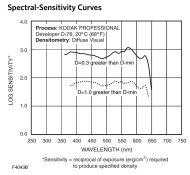
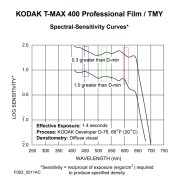

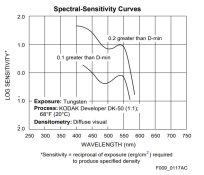
Finally, here's an actual Ortho film (tested under tungsten, mostly because it makes clear where the cut-off is).
View attachment 248404
I don't remember much were I learned that the very slow component in the T-Max formulation was barely ortho sensitized to allow that ultra low ISO to keep linearity in the extreme highlights.
...
the emulsion component than has ISO 0.25 to 2, if you dye sensitize much the smallest crystals then you may exceed the ISO you are targeting
If there was a truly orthochromatic emulsion in TMY-II you'd see it with an orange or red filter as it would cause tonalities from the mid-tones upwards to behave strangely and specular highlights to go wrong. It would be really obvious and people would complain.
No... because the ortho component only works in very high densities like those from bright light sources and glares, where light color is irrelevant..
Think about this for a minute: if you used a red #25 filter, it cuts everything below 575nm, if you used an ortho emulsion for the specular highlights, they won't really record at all because you have effectively placed a safelight filter in front of the lens. In fact they might appear instead as black 'blobs' in a print because there would be nothing recorded on the film. Furthermore, this problem would extend further down the tonal scale because emulsions are designed to link together in a visually continuous way without bumps at the transitions.
@earlz On the matter of HQMS, here's a patent for the synthesis of both HQMS salts.
I think '40 vol' works out to 12%, but don't quote me on that...
The synthesis looks pretty simple, but the hard part I'd assume is cleaning it up (remove excess sulfite) and drying it without oxidizing the HQMS
Well, it is what happens in fact with TMY if placing a red filter, it has a well lower sensitivity it the 600-650nm by 1.0D, and relative sensitivity should decrease more in that band by 2.0D, see again the spectral sensitivity graph.
Just for this reason a red filter has a remarkable compensating effect in the TMY highlights.
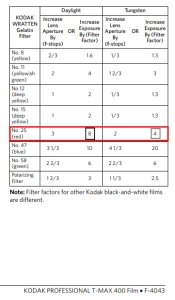
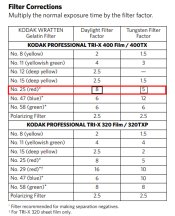

Uh, no.
T-Max 400 performs fine with a red filter. As does Fuji Acros. And the highlights perform perfectly normally unless you really screw up the processing with misplaced ideas about 'compensation'. This is really simple first-base stuff.
The filter factor numbers are in the data sheets, notice the difference between TX400 and TMY-II. T-Max 400's sensitivity remains high into the red, then cuts hard, Tri-X (TXP320 really, if you want to make separations with a #29) has a somewhat longer red sensitisation & cuts less hard, even if overall the red sensitivity is lower.
View attachment 248461 View attachment 248462
There was a guy here in this forum, @Nikola Dulgiarov , who went to great length to synthesize HQMS. He amassed a great library of patents and articles on that topic and did several experiments. He did get something going, but it was neither easy, nor a safe procedure to do at home.
I have Ron on record, that Formulary does not list every item they stock on their web page. It might be helpful to give them a call.
Just think about this: as spectral response varies depending on density (so on exposure) what happens is that not all emulsion components in the formulation have the same sensitization.
I know how highlights and specular highlights behave on ortho film under a large variety of lighting conditions very, very well. TMY-II very obviously does not behave like that.
You are equally pretty obviously not talking from any usefully comparative experience.
If you did have the least experience & knowledge of the materials in question, you wouldn't spend so much time defending such obviously flawed claims.
 again going to personal disacreditation questioniong other's "experience & knowledge" ??? Perhaps it's you that are looking uncapable to interpret a technical graph, beyond your own "experience & knowledge". LOL, Lachlan.
again going to personal disacreditation questioniong other's "experience & knowledge" ??? Perhaps it's you that are looking uncapable to interpret a technical graph, beyond your own "experience & knowledge". LOL, Lachlan.so will wisely avoid getting into any incipient war in the Pyrenees.
 The question is the TMX red sensitivity drop in the highlights datasheet shows.
The question is the TMX red sensitivity drop in the highlights datasheet shows. )) to see who makes the most wonderful mural print !
)) to see who makes the most wonderful mural print !| Photrio.com contains affiliate links to products. We may receive a commission for purchases made through these links. To read our full affiliate disclosure statement please click Here. |
PHOTRIO PARTNERS EQUALLY FUNDING OUR COMMUNITY:  |